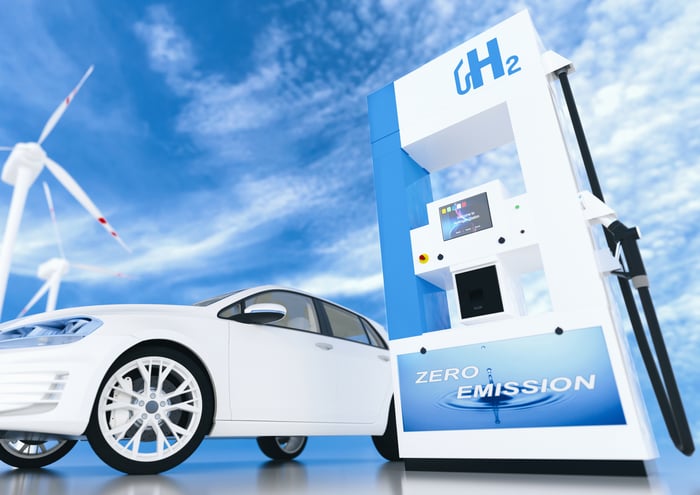Plug Power (PLUG 6.93%) stock fell 13.6% on Thursday, Feb. 25 after the company's fourth-quarter results missed the street's expectations. What's more, the fuel cell manufacturer reported negative revenue for the quarter. Though that sounds as bad as it can get, it isn't really so. Let's take a deeper look to understand why.
How Plug Power's revenue became negative
Plug Power reported revenue of negative $316 million for the fourth quarter and negative $100 million for the year. In contrast, company's gross billings were positive $96.3 million for the quarter and $337 million for full year. The annual gross billings rose 42.5% year over year.
The difference in gross billings and revenue is due to certain warrants that the company gave years ago to its key customer Amazon. In 2017, Plug Power granted Amazon warrants to acquire up to 55.3 million of Plug Power's common shares at roughly $1.20 per share. You can think of this as a kind of rebate that Plug Power, looking for customers, offered to Amazon to buy its fuel cells and services. Vesting of the warrants required Amazon to buy goods and services worth $600 million, over time, from Plug Power. Of this, Amazon expected to make purchases worth roughly $70 million in 2017.

Image source: Getty Images.
As you can see, the value of the warrants today, due to Plug Power stock's extraordinary rise, is far more than what Amazon paid for the services. So, the rebate is exceeding the purchase price, resulting in negative revenue from an accounting perspective.
To be fair, the outsize impact on the company's revenue is due to the extraordinary rise in Plug Power's stock price. As such, it is a non-cash expense for the company.
Plug Power noted that expenses relating to the warrants program for this customer are now fully expensed. Going forward, gross billings will be close to revenue under generally accepted accounting principles (GAAP).
There was nothing else in the results, except the negative revenue, that likely caused the stock to tumble. So, the stock's steep fall, for this reason, looks unreasonable. Having said that, several other reasons warrant a correction, bigger than this, in the stock. Here are three of them.
1. Plug Power faces significant risks
Plug Power faces numerous risks that can put it off its growth trajectory. The first one is slower-than-expected adoption of hydrogen fuel cells. The company has ambitious plans to grow its revenue in the next four years and beyond. However, hydrogen fuel cell's adoption, especially in the transport segment, has been slower than batteries over the years. Considering the lead that batteries already have, this trend could continue. That's because the infrastructure, such as filling stations, needed to grow adoption of hydrogen or electric vehicles requires time and investment. And it may not make sense for governments to spend on both electric and hydrogen technologies to achieve their clean energy objectives.
Additionally, Plug Power faces company-specific risks such as high customer concentration, increasing competition, and margin pressures in an industry that has low barriers to entry.
2. Attaining profitability remains a challenge
In more than 20 years of its operations, Plug Power has never been profitable. That's despite that fact that the costs of fuel cells have significantly fallen over the years. Though the company aims to generate $1.7 billion in annual revenue by 2024, its plans to achieve profitability are hazy at best. In the absence of any new catalyst, I don't see how falling costs and increased scale will make it profitable, when the same two things haven't done so in years.
3. Plug Power is overvalued
At $337 million of annual sales (or gross billings, if you like), the stock has a market capitalization of $23 billion. And the company hasn't generated any profits, ever. Due to the above reasons, the stock's valuation looks unjustified. If Plug Power fails to meet its lofty targets, which is quite likely, its stock will surely see a major correction.





